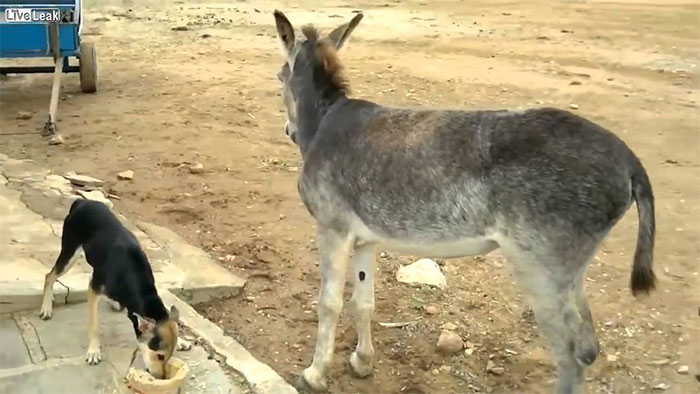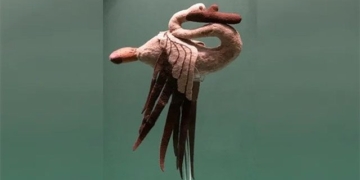The struggle for food taught the dog a valuable lesson.
The dog challenges the donkey for food and learns a lesson (source: LiveLeak).
In an interesting video captured in the suburbs, a dog and a donkey are both trying to eat food from a tray on the ground.
Despite being significantly smaller, the dog shows no fear and actively fights for and devours the food.
Hungry, the donkey approaches, hoping to share the meal, but is immediately chased away mercilessly. Even when the donkey sorrowfully picks up the leftover grains scattered on the ground, the dog coldly pushes it away.
Faced with the insatiable glutton, the donkey seems to reach its breaking point, silently turning its back to the dog and delivering a powerful kick right to the dog’s head.
Stunned by the blow, the dog “tucked its tail” and ran away without daring to look back. The calculated and very “human-like” behavior of the two animals has delighted the online community.
“Did that dog really think it could bully the donkey?”, commented user Ronald Colin. “This is truly a fitting punishment for the selfish one“, said user Royal Rover. “This really satisfies me. That’s exactly what that nasty dog deserved“, expressed user Alee Timm.

Contrary to popular belief, donkeys are very loyal, strong, and just as intelligent as horses.
In life, donkeys have faithfully served humanity for thousands of years. However, they are often referred to with unkind terms such as: “Donkey” or “Heavy-laden donkey“, referring to the story of a donkey that refuses to move until it has a heavy load on its back. Donkeys are also seen as symbols of clumsiness, stupidity, stubbornness, and obstinacy.
Nevertheless, in reality, donkeys are very strong and intelligent. They have an incredible memory, capable of recognizing areas and other donkeys they have been with for up to 25 years. A donkey is often stronger than a horse of the same size, which is why they are commonly used for heavy tasks such as carrying loads and agricultural work. For thousands of years, after human labor, donkeys have been considered the cheapest form of agricultural power, even less expensive than oxen.
In some cultures, donkeys are even viewed as symbols of humility, gentleness, and peace.
Compared to horses, donkeys are often seen as less attractive due to their shorter stature and four short legs. Depending on the breed and environmental conditions, donkeys typically stand between 90 cm and approximately 150 cm tall. They have a lifespan of 12 to 15 years.
Unlike wild horses, wild donkeys usually live alone in arid regions and seldom reproduce. Therefore, they only truly thrive when raised by humans, and their lifespan can increase to 30 to 50 years.
With average vision, donkeys primarily communicate through loud, long brays lasting about 20 seconds, allowing them to “talk” to other donkeys even across the vast expanses of the desert. To achieve this, donkeys have large ears that can pick up sounds from further away, and they help cool the donkey’s body. Donkeys can defend themselves by biting, attacking with their front hooves, or kicking with their hind legs.


















































